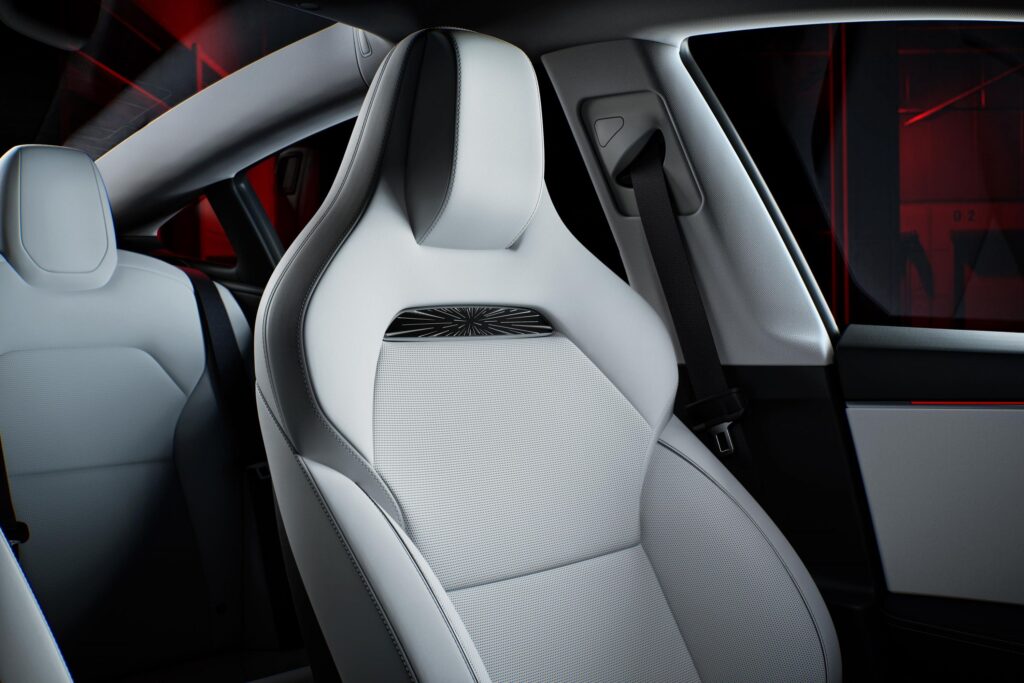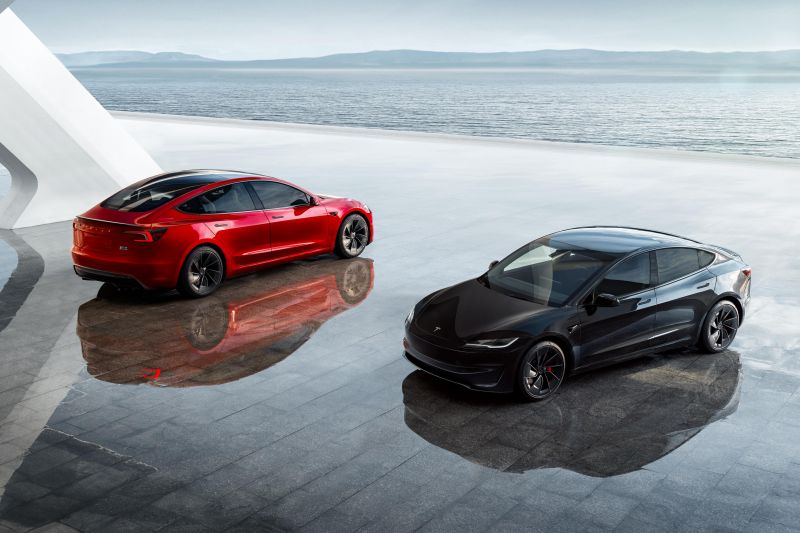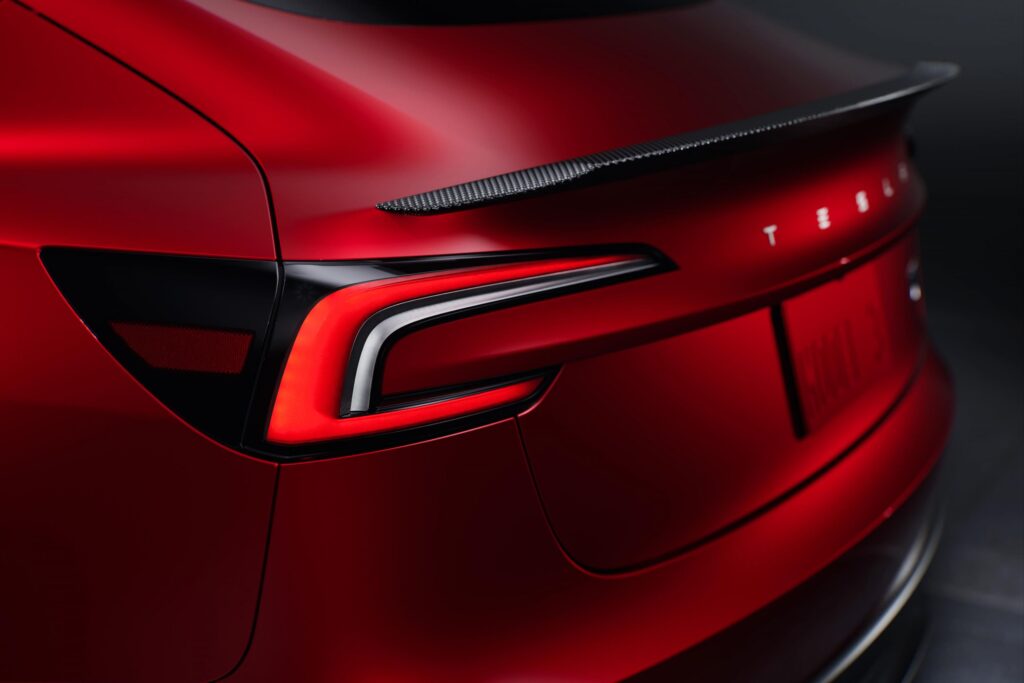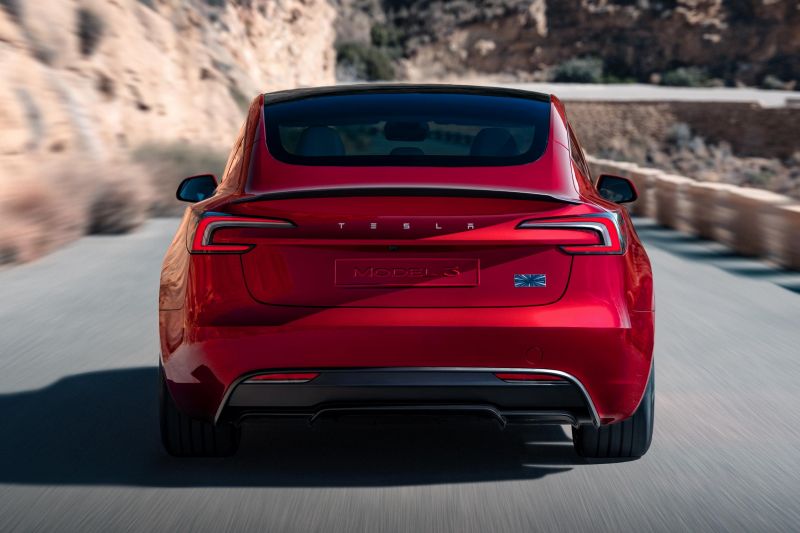Tesla has upgraded the performance version of its smallest car. The question is, how much has it changed over the previous car? One of the biggest changes isn’t visible from the outside of the car. It’s now fitted with adaptive dampers, so when you go into track mode it allows you to adjust the power distribution – perfect for if you’re looking to pull some skids! When it comes to the design, it’s all pretty similar to the previous car. Up front, there are some new headlights, as well as a redesigned front bumper and the inclusion of a splitter.
Along the side, the looks are pretty much identical, and at the rear, there’s a carbon fibre boot lip spoiler, and there’s also an updated bumper and diffuser. Step inside, and once again it’s all pretty similar. There’s a big screen on the dash (as always) coupled with some carbon fibre effect material, while there’s also a new pair of sports seats.
There are also no stalks on the steering wheel – indicators are now controlled by buttons instead! Apart from that, it’s all pretty identical to the previous car. One key change for this car is the addition of a new, higher-performance motor on the rear axle. As a result, the new Model 3 Performance can now produce 460hp! It’s fitted with the same 75kWh battery pack as before, which is apparently good for a range of up to 328 miles.
Motor & Performance
Tesla has given the new Model 3 Performance an uprated motor over the long-range model. As with the previous car, you’ve got a motor on the front and rear axles, but here you’ve got a beefier new rear-drive motor which delivers more power—460 horsepower from the combined system output. Plus, the car can provide more peak power and peak torque for longer than the old Model 3 Performance, which should improve the launch times.
Performance
In terms of performance, Tesla says this new Model 3 Performance should do 0-60 in 2.9 seconds.
Design
As with the normal Model 3, this Performance has Tesla’s new headlight design. Over the standard car, you get a slightly more aggressive front lower bumper with a splitter. Then there are 20-inch alloy wheels with these inserts that you can remove. Moving down the side, not much changes here over the standard car, but at the back, you have a carbon fibre boot lip spoiler which apparently provides some form of downforce. The lower part of the rear bumper has this diffuser. Something else that’s new: you might think it looks like a Plaid badge, but it’s not Plaid. it is the new Performance badge. It’s similar but different.
Interior
On the inside, you also get the new Performance badging on the sports seats. These seats come as standard with this Performance model, and they’re heated and cooled. They’re much better than the seats in the old Tesla Model 3 Performance. Another change is the carbon fibre effect on the dash and the touchscreen displays.

Back Seats
In the back, there’s plenty of space. Deep seat bases, a glass roof which is nice, sufficient headroom, and decent knee room. You also get a little screen here in the back, like you didn’t on the old Tesla Model 3. There are a few tweaks to the chassis of this car over the previous generation Model 3 Performance. It now has bespoke Pirelli tyres which are about 40 mm wider on the rear than they used to be. This should give it more grip. They’ve also reprogrammed the torque vectoring of how they distribute torque across the rear axle. Plus, the car has stiffer suspension top mounts, beefier anti-roll bars, and of course those adaptive dampers we’ve already mentioned.

Battery
The Model 3 Performance is fitted with the same 75 kWh battery pack as the standard Long-Range model. However, the way you might drive it could affect the efficiency. Now, Tesla says this car should be able to do 328 miles on a full charge.
Steering Wheel & Screen
Apart from the increase in performance and the improvement in handling, this Model 3 Performance is identical to a normal Model 3. You have to control most of the car’s functions through the screen and use these buttons on the steering wheel to access certain things. It’s really annoying that they don’t have indicator stalks anymore, and you have to use these buttons on the steering wheel. I also don’t like the swiping on the infotainment screen to put it into drive or reverse. It was much easier with the old car when you had the gear selector here.
Boot
Considering this is a performance car, it has a huge boot with 594 litres of space. If you need to, you can fold down the rear seats, though you have to go around to do it. It would be better if it was a hatchback because that would be more practical than the saloon-style boot opening. But I guess if you want that, there is, of course, the Tesla Model Y. As you’d hope from an electric car, you have a front boot with 88 litres of space there.

Town Driving
The latest version of the Tesla Model 3 Performance has improvements in comfort, and the new Performance model goes even further with its adaptive dampers. Switching from sport to standard mode softens the ride. It’s still firm, being a sporty model, but definitely less jarring than before. Don’t expect it to be as smooth as a BMW i4 M50. One advantage of this Tesla over the BMW is its turning circle—11.6 meters—making it more manoeuvrable.
Motorway Driving
On this rougher road, the difference between sport and standard suspension is noticeable. The changes in this Model 3 Performance are designed to help it stay flatter in bends. The steering is sharp and responsive, and the car grips well through corners
Verdict
Should you avoid it, consider it, shortlist it, or buy it? You should shortlist the Model 3 Performance. The performance for the money is incredible, making it a great value. However, something like a BMW M2 might be more fun to drive. Personally, I’d opt for the long-range version of the Model 3—it’s quick enough, goes further on a full charge, and is £10,000 cheaper.



















